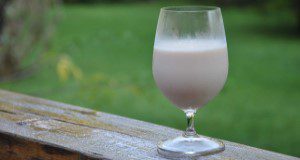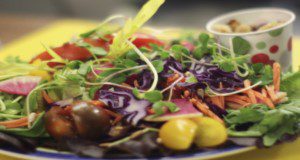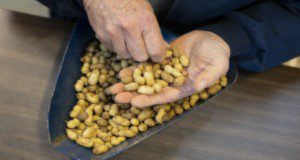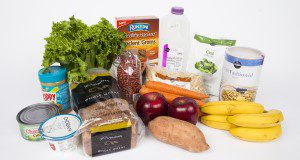La leche de soja es una leche vegetal elaborada a partir de semillas de soja (Glicine max). A diferencia de algunas de las leches de origen vegetal que se comercializan recientemente, la leche de soja tiene una larga historia como bebida en todo el mundo y se comercializa en los Estados Unidos durante más de un siglo. Si se ha preguntado cómo se compara con la leche de vaca, esta publicación describe los ingredientes y el contenido de nutrientes de la leche de soja producida comercialmente y sus posibles beneficios y riesgos para la salud.
This new 6-page publication of the UF/IFAS Food Science and Human Nutrition Department is the Spanish translation of FSHN20-54/FS422, Plant-Based Milks: Soy, written by Jessica Goldberg, Daniela Rivero-Mendoza, and Wendy J. Dahl.
https://edis.ifas.ufl.edu/fs430
Tag: Wendy Dahl
Nutricion para la salud y el estado fisico: azucar y otros edulcorantes
Esta publicación proporciona información sobre azúcares y otros edulcorantes en la dieta estadounidense. La publicación describe fuentes ocultas de azúcares agregados en los alimentos para ayudar a aquellos que desean reducir la ingesta de azúcar, a encontrar los azúcares agregados en sus dietas. La sección sobre edulcorantes de alta intensidad analiza las características de cada edulcorante aprobado.
This is the Spanish translation of FSHN20-46/FS406, Nutrition for Health and Fitness: Sugar and Other Sweeteners. Written by Wendy Dahl and Linda Bobroff, translated by Daniela Rivero-Mendoza, and published by the UF/IFAS Food Science and Human Nutrition Department.
https://edis.ifas.ufl.edu/fs407
Dietas populares: Ayuno intermitente
La pérdida de peso puede ser un desafío. Comenzar una dieta restrictiva puede ser agotador emocionalmente y difícil de cumplir. ¿Hay alguna forma más efectiva de perder peso? ¿El momento y la frecuencia de las comidas ayudan a perder peso? Esta publicación describe los beneficios y riesgos del ayuno intermitente para bajar de peso.
This new 4-page article is the Spanish language translation of FSHN20-47/FS409, Popular Diets: Intermittent Fasting, written by Michelle Yavelow, Daniela Rivero-Mendoza, and Wendy Dahl, translated by Daniela Rivero-Mendoza, and published by the UF/IFAS Food Science and Human Nutrition Department.
https://edis.ifas.ufl.edu/fs417
Dietas populares: Alimentos crudos
La dieta de alimentos crudos tiene sus raíces en un movimiento vegetariano que se remonta a los años 1800. Como su nombre lo indica, una dieta de alimentos crudos es un patrón dietético compuesto mayoritaria o completamente por alimentos crudos y sin procesar. Esta publicación explora los posibles beneficios y riesgos para la salud de una dieta de alimentos crudos.
This is the Spanish translation of FSHN20-45/FS404, Popular Diets: Raw Foods, written by Alexa Barad, Daniela Rivero-Mendoza, and Wendy Dahl, translated by Daniela Rivero-Mendoza, and published by the UF/IFAS Food Science and Human Nutrition Department.
https://edis.ifas.ufl.edu/fs415
Pérdida de peso y los adultos mayores: Riesgos y beneficios
A los adultos obesos a menudo se les aconseja perder peso para reducir el riesgo de enfermedades crónicas. Sin embargo, los beneficios para la salud de la pérdida de peso cambian a medida que envejecemos. Esta publicación analiza los riesgos y beneficios de la pérdida de peso planificada y no planificada para adultos mayores.
This is the Spanish translation of FSHN20-42/FS401, Weight Loss and the Older Adult: Risks and Benefits, written by Wendy Gans, Rachelle Savelle, Nancy Gal, and Wendy Dahl, translated by Daniela Rivero-Mendoza, and published by the UF/IFAS Food Science and Human Nutrition Department.
https://edis.ifas.ufl.edu/fs414
Dietas populares: Dieta cetogénica
La dieta cetogénica es una dieta alta en grasas y muy baja en carbohidratos. El primer uso documentado de la dieta cetogénica fue en 1921 para tratar la epilepsia en niños. En los últimos años, la dieta cetogénica ha ganado un resurgimiento como un medio potencial para perder peso. La dieta cetogénica se ha vuelto popular debido al respaldo de las celebridades y las influencias de las redes sociales, pero ¿es segura y efectiva?
This new 4-page article is the Spanish translation of FSHN20-44/FS403, Popular Diets: Ketogenic Diet. Written by Kelsey Gemmill, Daniela Rivero-Mendoza, and Wendy Dahl, and published by the UF/IFAS Food Science and Human Nutrition Department.
https://edis.ifas.ufl.edu/fs416
Popular Diets: Intermittent Fasting
Weight loss can be challenging. Starting a restrictive diet can be emotionally draining and difficult to adhere to. Is there a more effective way to lose weight? Does the timing and frequency of meals help to lose weight? This new 4-page publication of the UF/IFAS Food Science and Human Nutrition Department describes the benefits and risks of intermittent fasting for weight loss. Written by Michelle Yavelow, Daniela Rivero Mendoza, and Wendy Dahl.
https://edis.ifas.ufl.edu/fs409
Dieta e inflamación crónica
La inflamación es la respuesta de su cuerpo a las lesiones e infecciones—así es como su sistema inmunológico ayuda a protegerlo de cualquier daño. Por el contrario, la inflamación crónica contribuye a muchas enfermedades, como enfermedades cardíacas, diabetes y enfermedades renales y hepáticas. Esta publicación discute la inflamación y las opciones alimentarias que pueden ayudar a reducir la inflamación crónica.
This is the Spanish translation of FSHN20-43, Diet and Chronic Inflammation. Written by Daniela Rivero-Mendoza and Wendy Dahl, translated by Daniela Rivero-Mendoza, and published by the UF/IFAS Food Science and Human Nutrition Department.
https://edis.ifas.ufl.edu/fs405
Diet and Chronic Inflammation
Inflammation is your body’s response to injury and infection—it’s how your immune system helps to protect you from harm. In contrast, chronic inflammation contributes to many diseases, including heart disease, diabetes, and kidney and liver disease. This new 4-page publication of the UF/IFAS Food Science and Human Nutrition Department discusses inflammation and the dietary choices that may help to reduce chronic inflammation. Written by Daniela Rivero-Mendoza and Wendy Dahl.
https://edis.ifas.ufl.edu/fs402
Weight Loss and the Older Adult: Risks and Benefits
Adults who are obese are often advised to lose weight to reduce the risk of chronic disease. However, the health benefits of weight loss change as we become older, and unintentional weight loss is linked to its own set of health risks. This new 3-page publication of the UF/IFAS Food Science and Human Nutrition Department discusses the risks and benefits of planned and unplanned weight loss for older adults. Written by Wendy Gans, Rachelle Savelle, Nancy J. Gal, and Wendy Dahl.
https://edis.ifas.ufl.edu/fs401
Popular Diets: Raw Foods
The raw foods diet has its roots in a vegetarian movement dating back to the 1800s. As the name implies, a raw foods diet is a dietary pattern composed of mostly or completely raw, unprocessed foods. This new 3-page publication of the UF/IFAS Food Science and Human Nutrition Department explores the potential health benefits and risks of a raw foods diet. Written by Alexa Barad, Daniela Rivero-Mendoza, and Wendy Dahl.
https://edis.ifas.ufl.edu/fs404
Popular Diets: Ketogenic Diet
The ketogenic diet is a high-fat, very low carbohydrate diet. The first documented use of the ketogenic diet was in 1921 to treat epilepsy in children. In the past few years, the ketogenic diet has resurged in popularity as a potential means for weight loss. The ketogenic diet has become popular due to celebrity endorsement and social media influences. This new 4-page publication of the UF/IFAS Food Science and Human Nutrition Department explains the concepts behind this diet, explores the available menu, and examines whether this diet is safe and effective. Written by Kelsey Gemmill, Daniela Rivero-Mendoza, and Wendy Dahl.
https://edis.ifas.ufl.edu/fs403
Vegetarianismo y adultos mayores
Las dietas basadas en plantas se recomiendan para reducir el riesgo de enfermedades crónicas. Una dieta vegetariana es una dieta basada en plantas compuesta de vegetales, frutas, granos integrales, legumbres, nueces y semillas, con o sin alimentos a base de lácteos y huevos. Si se excluyen todos los alimentos de origen animal, se considera una dieta vegana. Las dietas vegetarianas y veganas bien planificadas pueden mejorar la salud durante todas las etapas de la vida, incluida la edad adulta. Sin embargo, cuando se sigue una dieta vegetariana como adulto mayor, se debe prestar especial atención a los cambios en las necesidades nutricionales relacionadas con la edad.
This new 4-page article is a translation of FSHN19-1/FS317, Vegetarianism and the Older Adult. Written by Kelly Johnston and Wendy J. Dahl, translated by Daniela Rivero Mendoza, and published by the UF/IFAS Food Science and Human Nutrition Department.
https://edis.ifas.ufl.edu/fs378
Meal Planning for Adults with Diabetes
Nutrition, physical activity, and medication are the three main components of a diabetes management plan. According to the Americans Diabetes Association, there is no one diabetes meal plan; rather, it is a healthful eating pattern specifically designed to meet your individual needs. This new 2-page publication of the UF/IFAS Food Science and Human Nutrition Department provides some basic tips for creating a personalized meal plan for adults with diabetes. Written by Nancy J. Gal and Wendy J. Dahl.
https://edis.ifas.ufl.edu/fs323
Diabetes Meal Planning: Managing Your Carbohydrate Intake
If you have diabetes, maintaining a consistent carbohydrate intake throughout the day is an effective meal-planning method to help maintain your target blood glucose levels. Foods that contain carbohydrates have the greatest effect on blood glucose levels compared to foods that contain primarily protein or fat. Carbohydrates in foods that contribute to blood glucose includes sugars and starches. The amount of carbohydrate you consume is based on your diabetes treatment goals and carbohydrate tolerance. This new 3-page publication of the UF/IFAS Food Science and Human Nutrition Department, written by Nancy J. Gal and Wendy J. Dahl, provides a strategy for planning your daily menu to manage your carbohydrate intake.
https://edis.ifas.ufl.edu/fs324
Fibra alimentaria y enfermedades crónicas
La fibra alimentaria tiene muchos efectos positivos en la salud. Esta publicación describe las relaciones entre la fibra alimentaria y la prevención y el tratamiento de enfermedades crónicas.
This new 2-page publication of the UF/IFAS Food Science and Human Nutrition Department is a Spanish translation of FSHN18-11/FS314, Dietary Fiber and Chronic Disease. Written by Wendy Dahl and translated by Daniela Rivero Mendoza.
https://edis.ifas.ufl.edu/fs322
¿Cuantas comidas debo comer cada dia?
Comer de manera saludable no se trata tanto de la cantidad de comidas y meriendas consumidas, sino de los tipos y las cantidades de alimentos totales consumidos en un día. Tratar de cumplir con las porciones recomendadas de los cinco grupos de alimentos, es decir, frutas, verduras, granos, proteínas y productos lácteos ayudará a promover la buena salud y prevenir enfermedades.
This new 2-page publication of the UF/IFAS Food Science and Human Nutrition Department is the Spanish translation of FSHN18-10/FS313, How many meals should I eat each day? Written by Zainab Alyousif and Wendy Dahl, and translated by Daniela Rivero Mendoza.
https://edis.ifas.ufl.edu/fs319
Seven New Spanish Translations in Food Science and Human Nutrition

The following new Spanish translations have been published in the Food Science and Human Nutrition Department:
- FS291/FSHN15-10S Enfermedad renal crónica: fósforo y su dieta by Nancy J. Gal, Lauren Headrick, Kate Bennett, and Wendy J. Dahl http://edis.ifas.ufl.edu/fs291
- FS292/FSHN16-3S Datos sobre grasas y aceites by Tiffany N. Stodtko and Wendy J. Dahl http://edis.ifas.ufl.edu/fs292
- FS293/FSHN16-9S Enfermedad renal crónica: Potasio y su dieta by Ashley R. Kendall, Nancy J. Gal, and Wendey J. Dahl http://edsi.ifas.ufl.edu/fs293
- FS294/FSHN16-1S Alimentos en puré: Guía para comidas rápidas by Wendy J. Dahl http://edis.ifas.ufl.edu/fs294
- FS295/FSHN12-18S Conteo de carbohidratos: Comidas para la Diabetes by Cassie Rowe, Jamila R. Lepore, and Wendy J. Dahl http://edis.ifas.ufl.edu/fs295
- FS296/FSHN16-4S Beneficios para la salud del aceite de olive y extractos de oliva by Wendy J. Dahl, Michael A. Tandlich, and Julie England http://edis.ifas.ufl.edu/fs296
- FS297/FSHN16-8S Una guía sobre probióticos y salud by Wendy J. Dahl http://edis.ifas.ufl.edu/fs297
Alimentos en Pure: Prueba de Textura con la Prueba de Desplome
This is the Spanish version of FS276 Pureed Foods: Texture Testing with the Slump Test. For individuals with dysphagia, the texture of puréed foods is extremely important. If the puréed foods are either too thick or too thin, it can make it more difficult to swallow. The slump test is a quick, easy, and inexpensive way to assess the texture of foods. This four-page fact sheet describes the slump test, how to perform a slump test, and how the slump test can be used to evaluate the texture of puréed foods. Written by Wendy J. Dahl, and published by the Food Science and Human Nutrition Department.
http://edis.ifas.ufl.edu/fs288
Chronic Kidney Disease: Potassium and Your Diet
Potassium is an essential mineral required for normal body function. It helps maintain normal blood pressure, fluid and electrolyte balance, muscle and nerve function, as well as bone density. This three-page fact sheet describes potassium and its normal dietary importance, as well as the impact potassium levels have on those with Chronic Kidney Disease. Written by Ashley R. Kendall, Nancy J. Gal, and Wendy J. Dahl and published by the Food Science and Human Nutrition Department.
http://edis.ifas.ufl.edu/fs287












